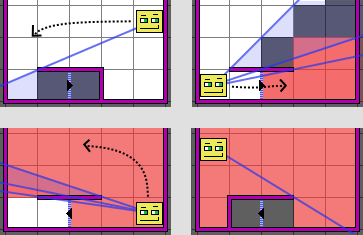Here's WarpField, a "portal-casting" field-of-view algorithm. This goes beyond the usual field-of-view mechanism by adding support for portals. A portal basically connects an edge between tiles in one map with an edge in a (possibly different) map. WarpField computes the field of view through the portal, and also returns what the player can see at each location. This could be useful for:
 |
| Going up (or down) stairs. |
- Continuous overworld movement from zone to zone
- Over/under pathways, such as bridges and tunnels
- Smooth transitions of elevation changes, like stairs
- Crazy magical effects, like portals to alternate dimensions.
"Portal-casting" is basically an extension of shadow-casting. Shadow-casting tracks contiguous ranges of angles of rays that are visible from the player. When a wall is encountered, we simply cut that range of angles out (causing a shadow). For portals, instead of cutting that range out, we split it off into a new, separate range. For each range we track which map the range "sees", and the relative tile offset into that map.
 |
| Entering a tunnel. |
There are a lot of edge cases to consider, and most of them are touched upon in the algorithm overview. I did a lot of testing and benchmarking, and I'm pretty sure it works according to spec, but there are some asymmetries that I'd like to remove (due to the order in which locations are visited). I think I can clean that up by switching to fractional math instead of floating-point math. Nevertheless, it's fairly robust, you can throw crazy cases at it like warps into the same map (such that the player can see themself through it), and rays that pass through many warps at once.
I think this could add a lot of potential to roguelike games.

